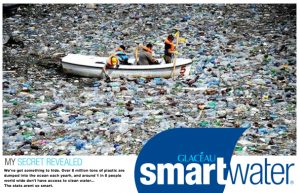The Original Ad

The Meaning Behind The Ad
The Smart Water ad featured above uses sexuality and fame to market a product that is a basic human necessity. This ad is problematic for a few reasons. Firstly, this ad is using the sexualization of a woman to sell their product. The text ‘My Secret Revealed’ suggests that Jennifer Aniston’s secret to beauty, success, and fame is this elaborately packaged water. This advertisement is effectively just selling a plastic bottle, and suggesting that is will lead to a life style like hers. Not only is this a ridiculous claim, but this ad is also perpetuating harmful beauty ideals. The ad features a sexualized thin white cis-woman. The media’s constant focus on this one type of body enforces the idea that this is what beauty is supposed to look like. This comes at the expense, and shames of all other female bodies.
Another problem with this ad is the centrality of privilege. Smart Water retails for approximately $2.50 a bottle. Many people don’t even have access to clean tap water, let alone the ability to afford such a luxury item. This product is being marketed as a means to showoff economic status, and privilege. As I stated above, water is a basic human necessity. For this reason, every human should have access to it for free, but instead it is being packaged and sold for exorbitant amounts.
Finally, Smart Water is owned by Coca-Cola. For the price of a 591ml bottle of of Smart Water, you could buy a two litre bottle of Coke. Water is obviously the healthy choice, but individuals who don’t have access to clean water are likely living in poverty, and may have to resort to drinking items like Coke because of the cost. It is ridiculous that this ad is marketing water as a luxury item. Effectively, the same company is exploiting people who are living in poverty by selling them products that negatively impact their health, and suggesting they are not deserving of healthy products.
The Jammed Ad

My Jamming Philosophy
Through the jammed version of my ad, I tried to show the dark realities of bottled water. While the initial ad stated ‘I have nothing to hide’, I replaced it with ‘we’ve got something to hide’, and statistics about water and plastic waste. These are things that companies selling bottled water want the consumer to ignore. The initial ad used sexuality and fame to mask the ridiculousness of spending $2.50 for something that should be a basic human right. I wanted to encourage the viewer to think critically about what kinds of information companies are trying to hide when they are marketing their products to consumers.
The initial photo was clean, and utilized sex appeal. I contrasted this in my new ad using a photo that shows the dirty side of buying bottled water: waste and pollution. By using a photo with people boating through the garbage I hoped to highlight that in actuality, plastic bottles aren’t very glamorous. I also presented statistics on the amount of plastic that ends up in the oceans each year to emphasize what a huge environmental problem plastic bottles pose. Through these alterations I aimed to get the viewer to think more critically about the consequences of buying bottled water.
The initial advertisement used fame and status as a marketing tactic. As I mentioned above, access to clean drinking water should be a basic human right. Unfortunately though, 1 in 8 people don’t have access to clean drinking water (The Water Project, n.d.). I included this statistic to provoke the viewer to consider what a privilege it is to have access to clean water, especially when it comes in such expensive packaging.
Women are disproportionately affected by the water crisis, as they are often responsible for collecting water. This takes time away from work, school and caring for family. Lack of water and sanitation lock women in a cycle of poverty.
Plastic Oceans. (n.d.). The Facts. Retreived June 27, 2017 from https://www.plasticoceans.org/the-facts/
The Water Project. (n.d.). Poverty and Water. Retrieved June 27, 2017 from https://thewaterproject.org/why-water/poverty